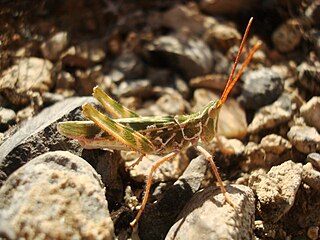
Pallas's grasshopper warbler, also known as the rusty-rumped warbler, is an Old World warbler in the grass warbler genus Helopsaltes. It breeds in the eastern Palearctic: from the Altai Mountains, Mongolia and Transbaikalia to northeastern China, the Korean Peninsula, and islands in the Sea of Okhotsk. It is migratory, wintering from India eastward to Indonesia. It is a rare migrant in Sri Lanka.

The lanceolated warbler is a species of Old World warbler in the grass warbler genus Locustella. It breeds from northeast European Russia across the Palearctic to northern Hokkaidō, Japan. It is migratory, wintering in Southeast Asia. The genus name Locustella is from Latin and is a diminutive of locusta, "grasshopper". This refers to the song of the common grasshopper warbler and some others in this genus. The specific lanceolata is Latin for "spear-shaped" and refers to the streaks on the breast.

The river warbler is an Old World warbler in the grass warbler genus Locustella. It breeds in eastern and central Europe, and into the western Palearctic. It is migratory, wintering in inland southern Africa, from around the Zambezi River south to the vicinity of Pretoria in South Africa. The genus name Locustella is from Latin and is a diminutive of locusta, "grasshopper". This refers to the song of the common grasshopper warbler and some others in this genus. The specific fluviatilis is Latin for "of a river".

The guenons are Old World monkeys of the genus Cercopithecus. Not all members of this genus have the word "guenon" in their common names; also, because of changes in scientific classification, some monkeys in other genera may have common names that include the word "guenon". Nonetheless, the use of the term guenon for monkeys of this genus is widely accepted.

Acrolophitus pulchellus is a species of grasshopper in the family Acrididae. It is endemic to Idaho in the United States. Its common name is Idaho point-headed grasshopper.
Chloealtis aspasma is a species of grasshopper in the family Acrididae. It is native to northern California and southern Oregon in the United States. It is known by the common names Siskiyou short-horned grasshopper and Siskiyou Chloealtis grasshopper.
Conozoa hyalina, the California Central Valley grasshopper or just Central Valley grasshopper, was a species of grasshopper in the family Acrididae, now extinct. It was endemic to the United States.
Eumorsea pinaleno is a species of grasshopper in the family Eumastacidae. It is endemic to the Arizona in the United States, where it is likely restricted to the Pinaleno Mountains. It is known commonly as the Pinaleno monkey grasshopper.
Spaniacris deserticola is a species of grasshopper in the family Romaleidae known as the Coachella Valley grasshopper and spanistic desert grasshopper. It is known from a few locations in the deserts of southern California and just across the border in Sonora, Mexico.
Tetrix sierrane is a species of grasshopper in the family Tetrigidae. It is endemic to the United States.
Tettigidea empedonepia, the Torreya pygmy grasshopper, is a species of grasshopper in the family Tetrigidae. The type locality is Camp Torreya in Liberty County, Florida. According to Orthoptera Species File, it has also been found in Cuba.
Trimerotropis occulens, the Lompoc grasshopper, is a species of grasshopper in the family Acrididae. It is endemic to the United States.

Glyptemys is a genus of turtles in the family Emydidae. It comprises two species, the bog turtle and wood turtle, both of which are endemic to North America. Until 2001, these turtles were considered members of the genus Clemmys, which currently has one member, the spotted turtle.

Vaccinium oxycoccos is a species of flowering plant in the heath family. It is known as small cranberry, marshberry, bog cranberry, swamp cranberry, or, particularly in Britain, just cranberry. It is widespread throughout the cool temperate northern hemisphere, including northern Europe, northern Asia and northern North America.
The Maspalomas bow-legged grasshopper is a species of grasshopper of the family Acrididae. The species is endemic to the town of Maspalomas on Gran Canaria Island, and is considered Critically endangered, or almost extinct, since it hasn't been found since 1949.
Psychomastax deserticola, the desert monkey grasshopper, is a species of monkey grasshopper in the family Eumastacidae. It is found in North America.







